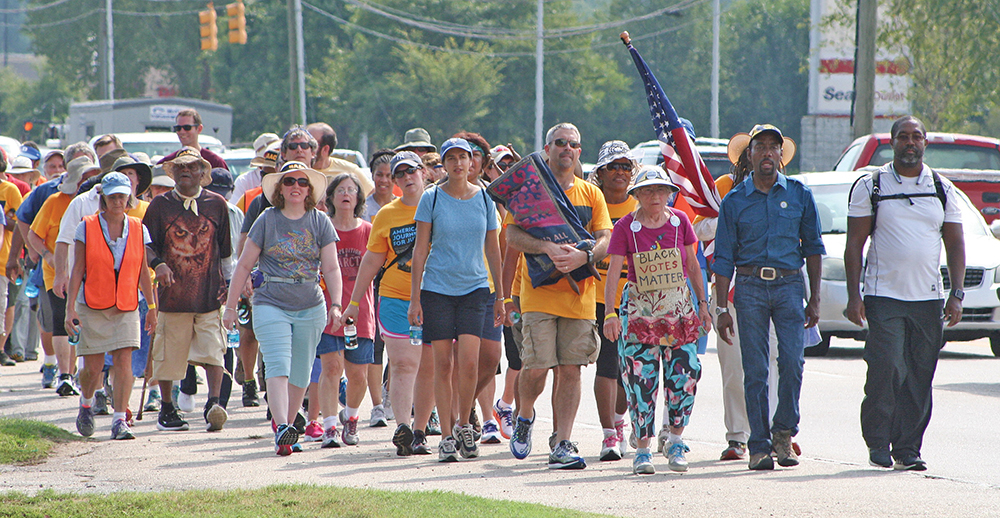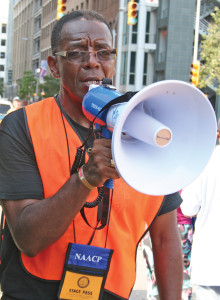N.C. civil rights marchers & NAACP focus on voting rights
 Journey for Justice marchers travel down Wilmington St. toward the State Capitol building in Raleigh. The march was led by 85-year-old Ruth Zalph (left), wearing a Black Lives Matter sign and Cornell William Brooks (right), president of NAACP. Photos by Afrique Kilimanjaro/Carolina Peacemaker
Journey for Justice marchers travel down Wilmington St. toward the State Capitol building in Raleigh. The march was led by 85-year-old Ruth Zalph (left), wearing a Black Lives Matter sign and Cornell William Brooks (right), president of NAACP. Photos by Afrique Kilimanjaro/Carolina PeacemakerRALEIGH- America’s Journey for Justice, an 860 mile walk led by the NAACP, has been deemed the longest walk advocating civil rights in history. The distance traveled in this walk is longer than Mohandas Gandhi’s 240 mile Salt March in 1930 and seventeen times the distance marched from Selma, Alabama to Montgomery, 50 miles, in 1965.
The journey began August 1 at the Edmund Pettus Bridge in Selma, Alabama, in remembrance of the events of Bloody Sunday where civil rights marchers advocating for voting rights were severely beaten by Alabama State Troopers at the bridge on March 7, 1965. The starting date of the journey also closely coincides with the 50th anniversary of the passage of the Voting Rights Act on August 6, 1965. Cornell Brooks, president of the NAACP and leader of the Journey for Justice, said the march will be carried out by hundreds, if not thousands of people “to demand federal protection of civil rights for all Americans.”
Approximately 13 marchers from Greensboro gathered before dawn at Temple Emanuel to travel by van to the small town of Fuquay Varina, a suburb southwest of Raleigh. The small group from Greensboro was comprised of members from Greensboro’s Jewish and Quaker communities, representing Temple Emanuel, Beth David Synagogue and New Garden Friends School. They walked a 12 mile span to Raleigh demonstrating their solidarity with Journey for Justice pa rticipants. Also participating were 15 reform and conservative rabbis who gathered from across the country to march and take turns carrying the Torah (Five Books of Moses).
 Rev. Curtis Gatewood of Durham leads marchers in a spirited chant.
Rev. Curtis Gatewood of Durham leads marchers in a spirited chant.Each Journey for Justice participant walked in pairs flanked by eight NAACP field marshals wearing orange safety vests. The group was led by Brooks, along with walkers from Selma carrying the U.S. Flag. Also present were escorts from the North Carolina Highway patrol, local law enforcement officers, followed by three buses- including a first aid station and several passenger vans.
North Carolina’s participation in America’s Journey for Justice maintained a laser sharp focus on voting rights as the marchers walked with determination through the state. Currently, North Carolina is at the forefront of the battle over voting rights.
In 2013, the U.S. Supreme Court struck down Section 4b and 5 of the Voting Rights Act of 1965. Section 4b provided a formula which helped determine which jurisdictions would be subjected to preclearance based on their histories of discrimination in voting. Section 5 required several Southern states, including North Carolina, and other municipalities across the country to obtain federal preclearance prior to enacting any changes to their voting laws.
With such provisions no longer law, the Republican led N.C. General Assembly along with Gov. Pat McCrory, swiftly passed the most restrictive set of voting laws in the United States. North Carolina’s H.B. 589 systematically “shortens early voting, eliminates same day registration during the early voting period, prohibits voters from casting out-of-precinct provisional ballots, expands the ability to challenge voters at the polls, eliminates a pre-registration program for 16 and 17 years-olds and requires voters to show a photo ID prior to voting.”
Rev. Dr. William J. Barber, chairman of the N.C. Conference of the NAACP, has been leading the charge to oppose such voting laws. At least two lawsuits addressing H.B. 589 are currently making their way through the federal courts. Barber said, “This law is the worst kind of voter ID. It’s the worst attack on voting rights to disenfranchise racial minorities, the poor and young people since Jim Crow. This bill is why we need full implementation of the voting rights act. Supporters of H.B. 589 are trying to suppress the vote in North Carolina in every way possible.”
A bipartisan group of members of Congress introduced the Voting Rights Amendment Act of 2014 (“VRAA”). Congressmen John Lewis (D-GA-5), James Sesenbrenner (R-WI-5), Steve Chabot (R-OH-1) and John Conyers Jr. (D-MI-13), introduced H.R. 3899 in the House. Senator Patrick Leahy (D-VT) and other U.S. Senators introduced a companion bill, S. 1945, in the Senate on the same day. According to the sponsors of the legislation, “The House and Senate legislation is a first step in restoring voting rights protections now at risk because of the U.S. Supreme Court’s decision last June in Shelby County, Alabama v. Holder.”
Once America’s Journey for Justice reaches Washington, D.C., marchers and a host of civil rights advocates will actively seek their legislators’ support for ratification of the VRAA.
Rev. Curtis Gatewood, second vice president of the N.C. NAACP, told the marchers and supporters gathered for a Raleigh rally that voting is important. “You’re going to have to vote to elect the sheriff who will hire the deputies. You’re going to have to vote to elect the city council that will hire the police chief. So we want you to understand that voting is an important element in the movement for justice.” Gatewood led marchers in chants along the route through the state.
Also present at the Raleigh rally from Greensboro were: Rev. Dr. T. Anthony Spearman, third vice president of the N.C. NAACP and pastor of St. Phillips AME Zion Church; Greensboro NAACP Board members and Beloved Community Center founders, Rev. Nelson Johnson and Joyce Johnson; Lewis Brandon with Beloved Community Center; and Rev. Cardes Brown, former president of the Greensboro Branch NAACP.
Teach-in sessions addressing civil rights issues such as economic equality, a living wage, sustainable jobs, education, criminal justice reform and equitable public education, in addition to voting rights will continue at churches and schools as the marchers arrive in the nation’s capital. Journey for Justice organizers anticipate that marchers will reach Washington, D.C by September 15 for a rally at the Lincoln Memorial followed by a legislative lobbying day on September 16.